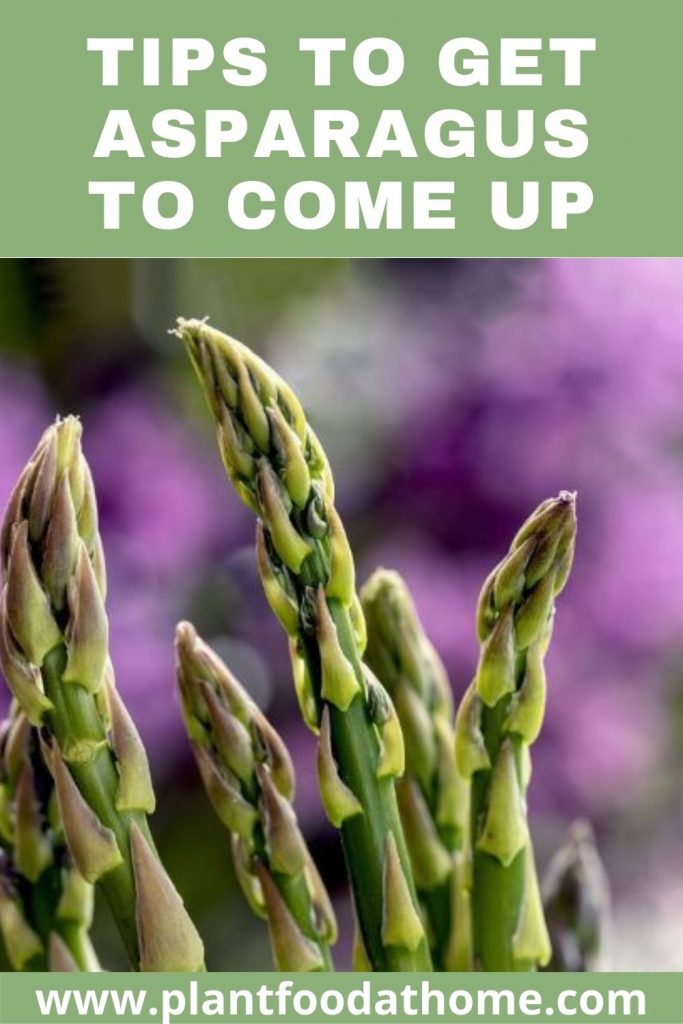If you’re looking at your vegetable garden and asking yourself, “Why isn’t my asparagus coming up?” then you’ve come to the right place. Asparagus can be a tricky vegetable to grow if you don’t know how to. So here are some helpful tips for growing asparagus so you can have a successful harvest.
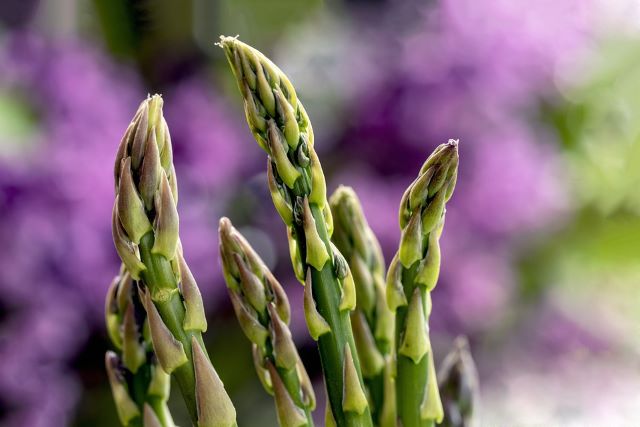
Asparagus can be one of the most rewarding vegetables in your garden as it is one of the first to come up in spring. And as a perennial plant, meaning it will come up year after year, you only have to plant it once. But asparagus does need a bit of love and care to get it growing, especially in the first 2 years.
Table of Contents
- Climate For Growing Asparagus
- Soil For Growing Asparagus
- Have Patience – Harvesting Asparagus
- Growing Asparagus From Seeds
- Use Male Asparagus Plants
- Planting Site For Asparagus
- Planting Asparagus Crowns
- Weeding and Mulching Asparagus Plants
- Watering Asparagus Plants
- Don’t Cut Asparagus Ferns Down Too Early
- Final Thoughts
Climate For Growing Asparagus
Asparagus will grow in most moderate climates but it prefers cooler climates with long, cold winters.
In mild winter climates, asparagus can be planted in late fall or early winter. In cold winter climates, asparagus can only be planted in spring after the last frosts.
Soil For Growing Asparagus
Asparagus likes slightly sandy soil that drains well but also likes rich soil so you will need to add plenty of compost and aged manure. It likes neutral to slightly acidic soil with a pH range of 6.5 – 7.5. You can test your soil pH easily with a soil monitor like this one.
Have Patience – Harvesting Asparagus
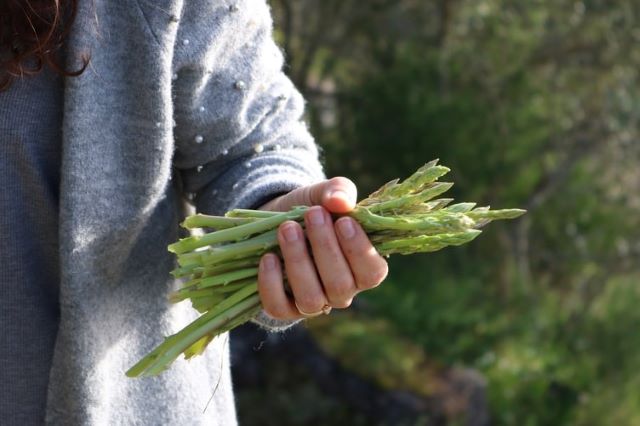
The most important tip regarding growing asparagus is that you should not harvest your asparagus for the first two or three seasons. This allows the asparagus plants to be fully established.
If you are planting asparagus from seed you will need to wait at least three years before harvesting. If you are planting asparagus from a crown you will only need to wait one or two seasons as the crowns you buy are usually a year old.
Once asparagus plants are established you can harvest the spears for up to 30 years!
When your asparagus plant is old enough to harvest from, it will provide many spears in the early spring with new spears appearing every few days. You can continue to pick the spears throughout the growing time which lasts around 4 to 8 weeks depending on the age of your plant.
Any spears that have begun to open will be too tough to eat. Cut these spears off and discard them. Harvesting spears encourages the plant to produce more spears.
Spears will become narrower as the season progresses. So stop harvesting when asparagus spears are as thin as a pencil. Then allow these spears to grow into ferns.
How to Havest Asparagus
Asparagus can be harvested in two ways. If you want to eat green asparagus, you need to wait for the spear to grow about 6 to 10 inches (15-25 cm) above the ground. Younger spears will obviously be more tender.
Then cut the spear at its base where it meets the ground. You can use a sharp knife to cut the spears or you can snap them off at the base. Snapping them off may be a better method as a knife could spread disease from plant to plant.
If you want to eat white asparagus, it is easier to harvest them if they’re grown in a raised bed. Wait for the spear to protrude about half an inch above the ground. Then dig down into the earth mound and cut the asparagus stem about 5 to 7 inches from the tip. This stem should be white as it has not been exposed to sunlight.
Growing Asparagus From Seeds
If you are planting asparagus from seed, it is best to plant them indoors in late winter or early spring. For best results soak the seeds overnight in water.
Plant the asparagus seeds in a good growing medium like this seed raising mix, in seed trays.
Allow them to grow indoors for 12 to 14 weeks, keeping the soil lightly moist, before planting them out.
You can leave the seed trays outside for the last two weeks before planting out. This is a good way to transition the plants from the complete protection of indoors to the outdoor elements.
A good tip here for the patient gardener is to plant the new asparagus seedlings out into a temporary bed first. This will allow you to see which asparagus plants are male and which are female before planting into your main bed the following year.
Use Male Asparagus Plants
If you are planting asparagus from seed or buying crowns you will not know which are male and which are female. But once they have had their first growing season you will be able to identify the asparagus plants by the berries. Females have small red berries in the foliage in fall while the males do not.
Female asparagus plants expend a lot of energy creating and feeding the berries and therefore their yield of spears is less than male plants.
Male asparagus plants are much more prolific when it comes to producing spears so if you want to maximize your space and get a bumper crop for years to come it is worth sacrificing the female plants and only planting out the males.
Some newer cultivars, such as Jersey Supreme and Jersey Knight, are all-male asparagus cultivars. Male plants can produce three times more spears than female plants.
Choosing one of these all-male cultivars will save you the trouble of planting in a temporary bed first and will give you a prolific spear-producing asparagus bed.
Planting Site For Asparagus
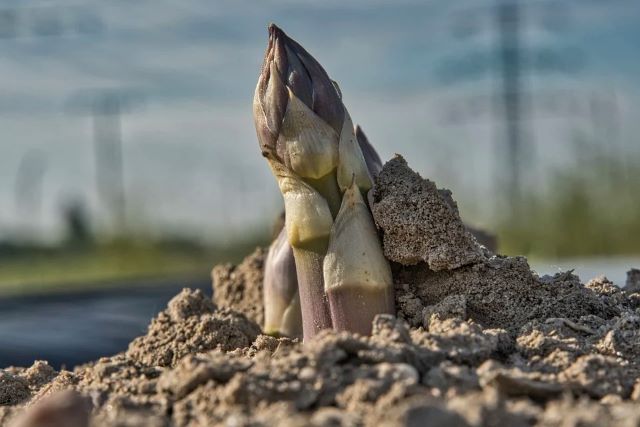
Choose your planting site carefully as this will be your asparagus patch for up to 30 years.
Full Sun: Asparagus grows best in full sun although it can do well in an area that receives 60% sun or more.
Good Drainage: Asparagus does not like its roots to sit in water. If your soil does not have good drainage try planting in a raised bed. A raised bed will ensure the water drains away well.
6.5 – 7.5 pH: Asparagus likes neutral to slightly acidic soil.
Planting Asparagus Crowns
As asparagus is a perennial, make sure you buy the best quality crowns you can find as they will be there for decades.
If your soil has good drainage, dig a trench 18 inches (45 cm) wide and 8 inches ( 20 cm) deep.
In the trench make a 2-inch-high (5 cm) mound of soil and compost mix down the middle. You can add a little organic fertilizer to the mix here too.
Place the crowns on the mound about 18 inches (45 cm) apart.
Spread asparagus crown roots out evenly and arrange them to hang over the mound.
Cover the crowns with 2 inches (5cm) of compost and soil mix.
Water well.
As the asparagus spears grow during the season, continue to add soil, 2 inches (5 cm) at a time, allowing the tips of the spears to remain above the ground.
Once the trench is full, continue to add soil until the bed is raised at least 4 inches (10 cm) above ground level to ensure water does not pool around the plants and rather drains away.
If your soil does not have good drainage, do not dig a trench. Rather create a 2-inch-high (5 cm) ridge of soil and compost on the ground and place the crowns onto this raised ridge. Pile 2 inches (5 cm) of soil and compost up and onto the crowns.
Continue to pile on soil as the spears grow, 2 inches (5 cm) at a time, to create a raised bed.
Weeding and Mulching Asparagus Plants
One of the biggest issues when growing asparagus is controlling weeds, especially in the first 2 years.
Asparagus plants don’t like competition of any kind and all weeds should be removed.
Because asparagus roots are very sensitive they should not be disturbed at all during the first 2 years as they are settling.
It’s therefore important that you carefully pull each weed out by hand, making sure the asparagus roots are not disturbed.
You can also put on a layer of mulch which will decrease the amounts of weeds coming up. Straw, shredded leaves or even damp newspaper are good options for mulch to help control weeds.
Watering Asparagus Plants
During the first two years, asparagus plants need 1 to 2 inches of water per square foot per week. Asparagus loves water but does not like its roots to sit in water. Drip irrigation is a great option for delivering the right amount of water on a regular basis.
Don’t Cut Asparagus Ferns Down Too Early
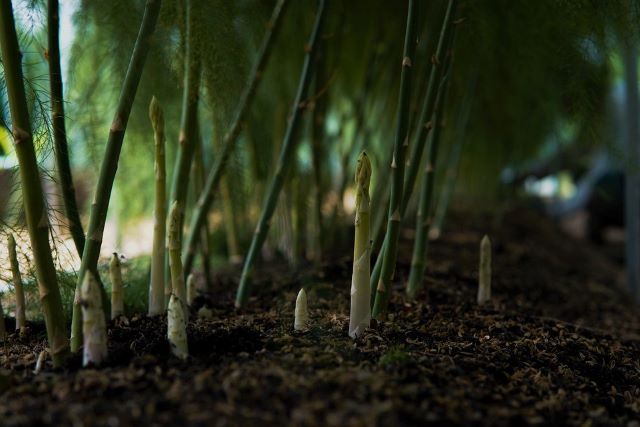
Make sure you allow the end-of-season asparagus spears to grow out into ferns. Allow these ferns to mature and go through the full life cycle. Water, feed and mulch the ferns throughout the summer.
Doing this will replenish the roots and the rest of the asparagus plant and will ensure that the next year’s crop is healthy and plentiful.
The healthier the ferns are, the better the following years’ asparagus crop will be. Only cut the asparagus ferns back when they have turned brown and look dead. This will probably only happen in the winter. Cut them right down to the ground.
Then once you have cut the ferns down you no longer need to water and feed the plants as they will be dormant for the winter.
If you cut the ferns too early you risk ruining your asparagus plant.
Final Thoughts
If you’ve ever had trouble with your asparagus not coming up, be sure to go through these growing tips to make sure you are providing the ideal growing conditions. Once you find the problem, implement the solution and you’ll enjoy a thriving harvest of asparagus. Happy growing!
Further reading:
- Why Is My Asparagus Dying? Causes and Solutions
- Why Is My Asparagus Bitter?
- Why Is My Broccoli Flowering? Causes and Solutions!
- How to Start Sweet Potato Slips for Growing Sweet Potatoes (With Photos)
- Why is my Eggplant Flowering But No Fruit (Causes and Solutions)
- Perennial Vegetables to Plant Once and Harvest Forever
